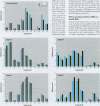Abstract
As a consequence of contamination by effluents from local electronics manufacturing facilities, the New Bedford Harbor and estuary in southeastern Massachusetts is among the sites in the United States that are considered the most highly contaminated by polychlorinated biphenyls (PCBs). Since 1993, measures of intrauterine PCB exposure have been obtained for a sample of New Bedford area infants. Among 122 mother-infant pairs, we identified four milk samples with total PCB levels that were significantly higher than the rest, with estimated total PCBs ranging from 1,100 to 2,400 ng/g milk fat compared with an overall mean of 320 ng/g milk fat for the 122 women. The congener profile and history of one case was consistent with past occupational PCB exposures. Otherwise, the source of PCB exposures in these cases was difficult to specify. Environmental exposures including those from fish consumption were likely, whereas residence adjacent to a PCB-contaminated site was considered an unlikely exposure source. In all four cases, the infants were full-term, healthy newborns. Because the developing nervous system is believed to be particularly susceptible to PCBs (for example, prenatal PCB exposures have been associated with prematurity, decrements in birth weight and gestation time, and behavioral and developmental deficits in later infancy and childhood, including decrements in IQ), it is critical to ascertain if breast-feeding is a health risk for the women's infants. Despite the potential for large postnatal PCB exposures via breast milk, there is limited evidence of significant developmental toxicity associated with the transmission of moderate PCB concentrations through breast milk. Breast-feeding is associated with substantial health benefits including better cognitive skills among breast-fed compared with formula-fed infants. We conclude, based on evidence from other studies, that the benefits of breast-feeding probably outweigh any risk from PCB exposures via breast milk among the four New Bedford infants. In this case report, PCB analysis of breast milk and infant cord serum was a research tool. PCB analysis of milk is rarely done clinically, in part because it is difficult to use the results of such analyses to predict health risks. Substantial effort is needed to achieve a better understanding of the clinical and public health significance of PCB exposures, particularly among potentially susceptible groups such as infants and children. Such efforts are critical to improving the clinical and public health management of widespread and ongoing population exposures to PCBs.
Full text
PDF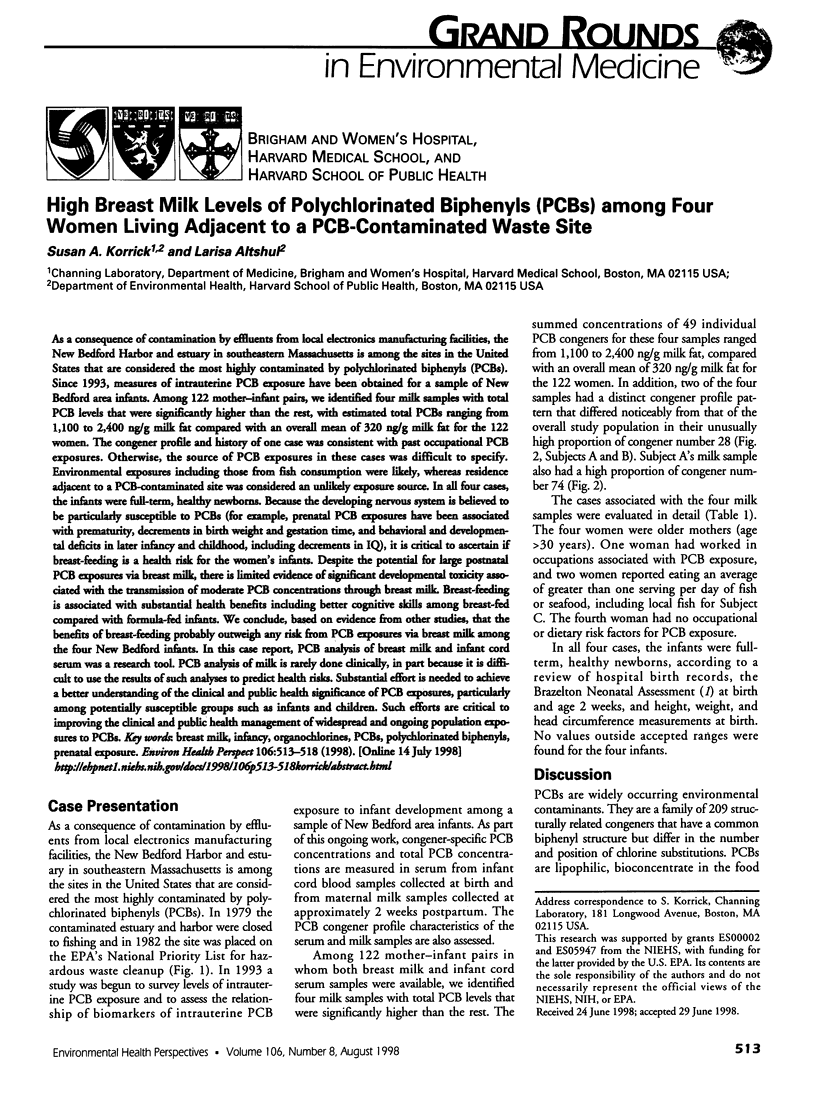
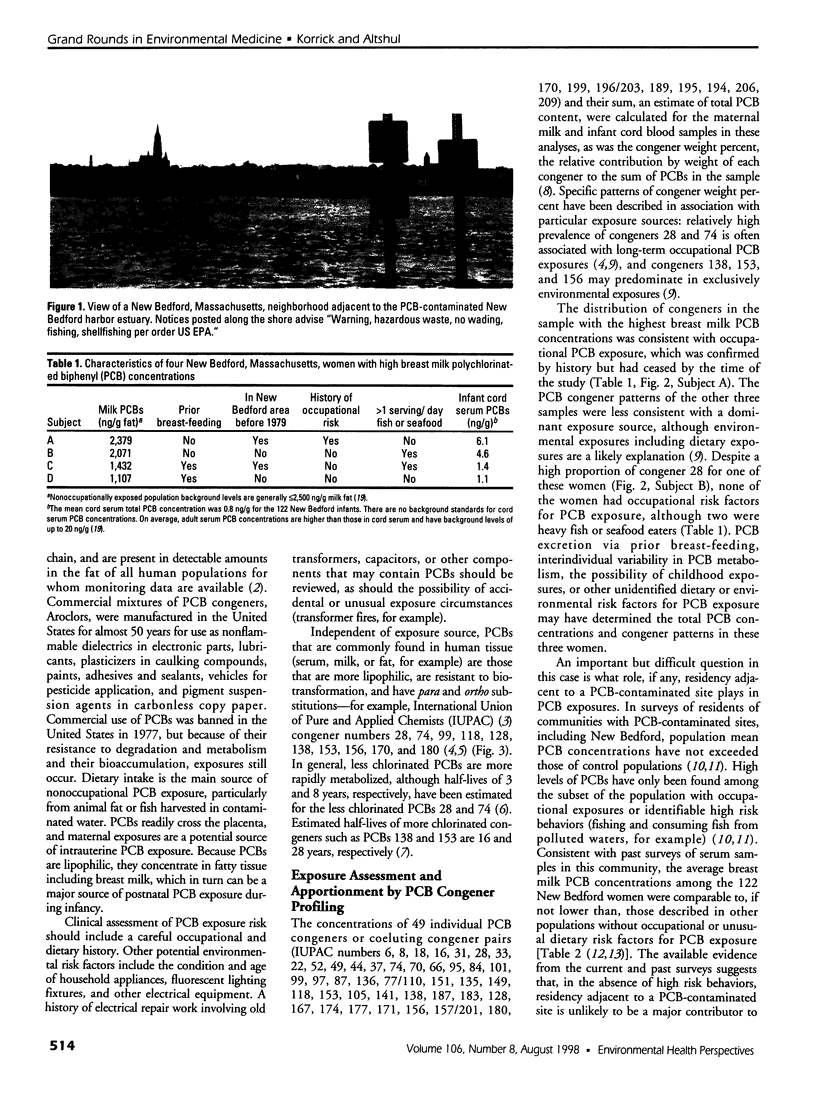
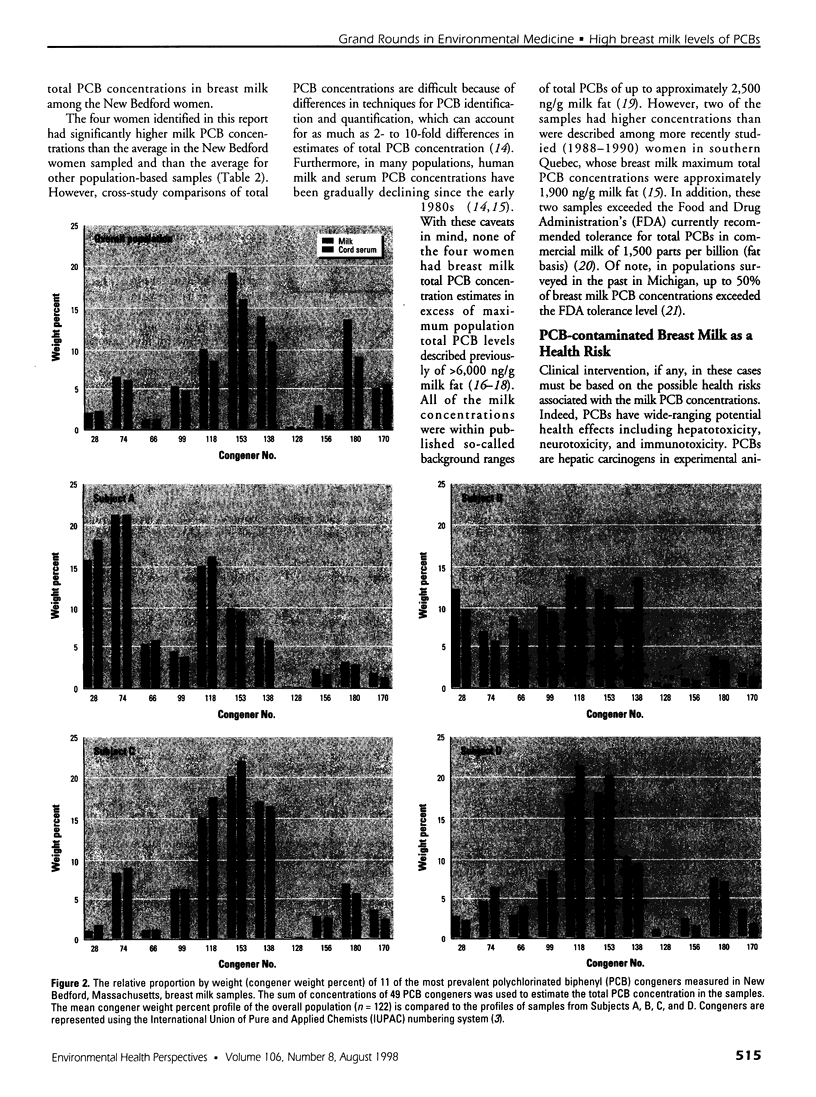
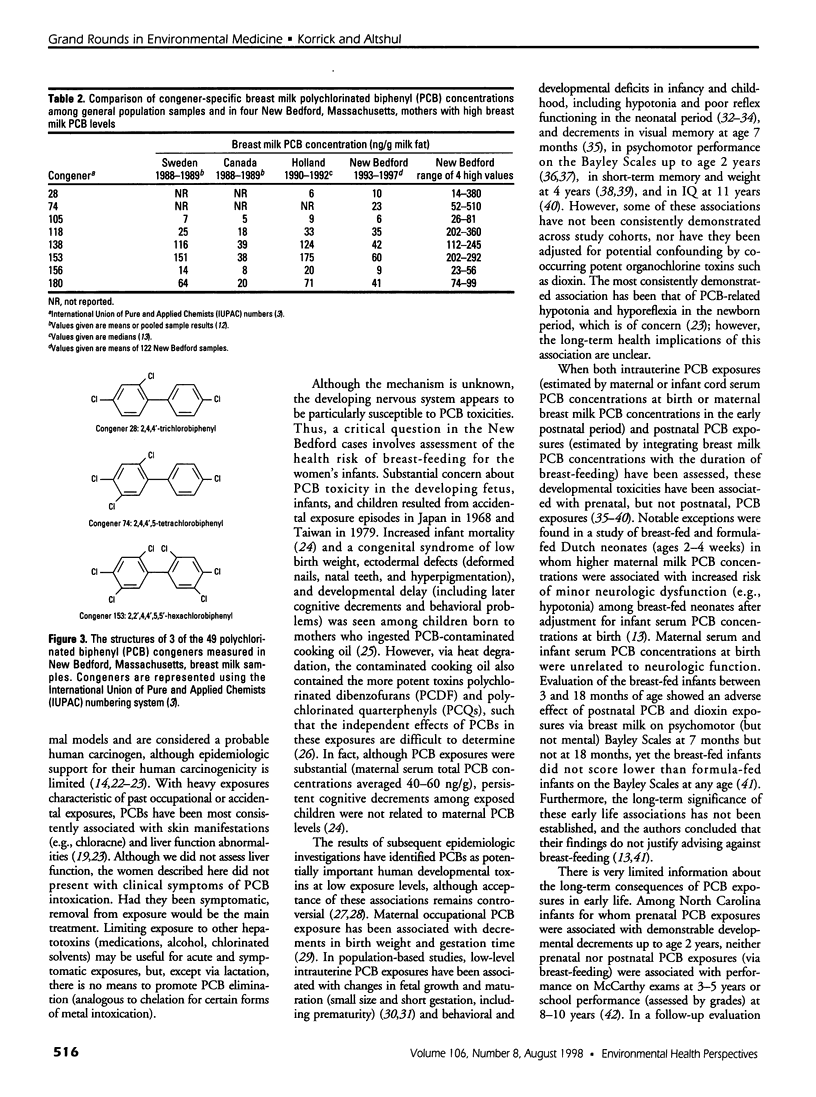
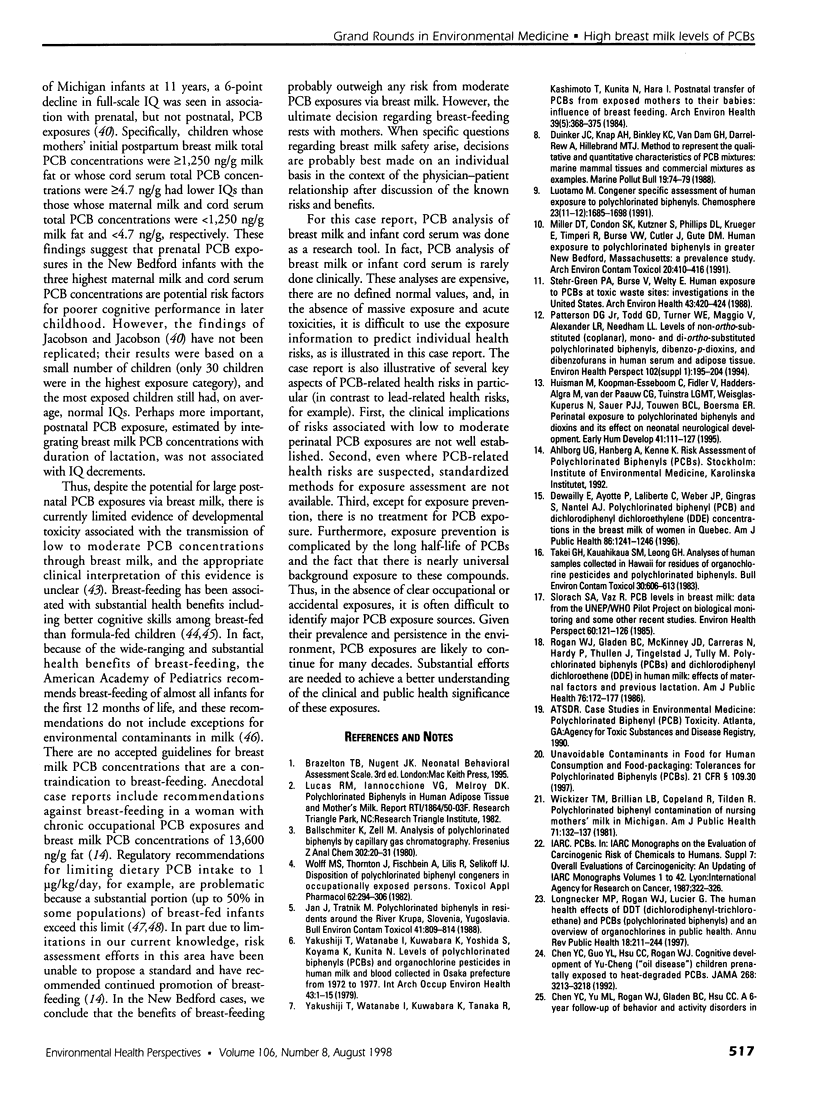
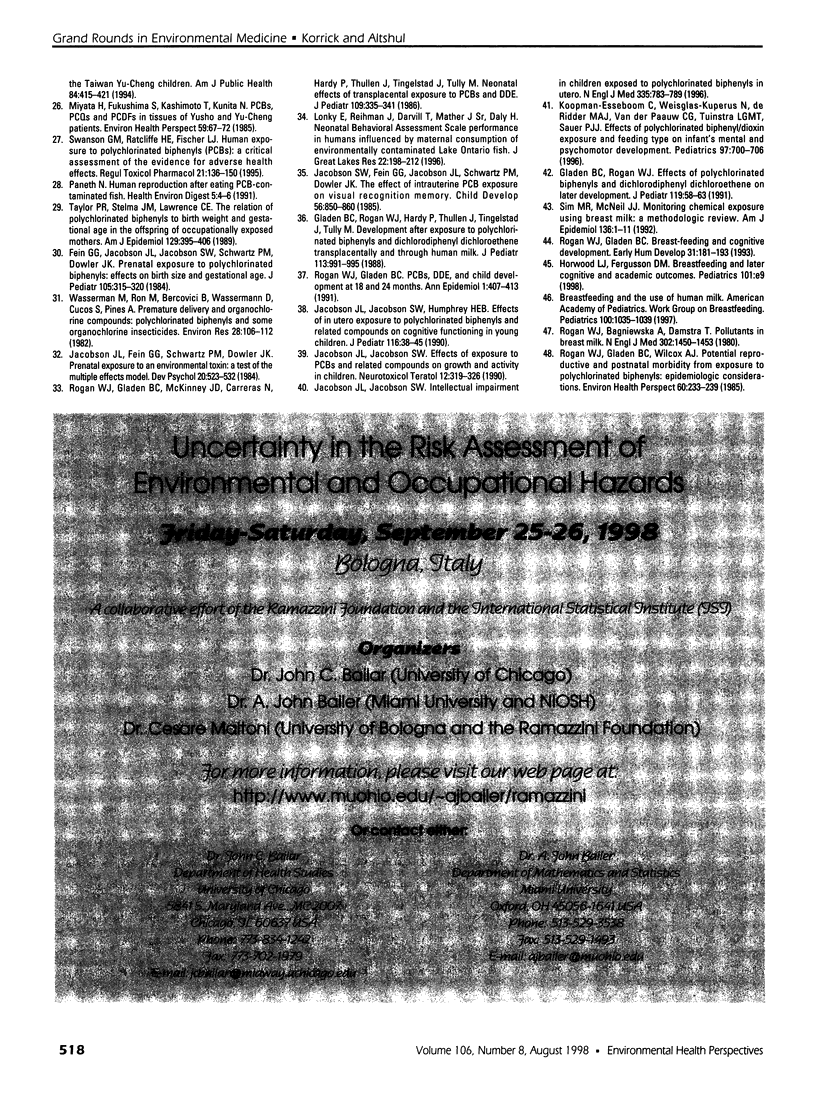
Images in this article
Selected References
These references are in PubMed. This may not be the complete list of references from this article.
- Chen Y. C., Guo Y. L., Hsu C. C., Rogan W. J. Cognitive development of Yu-Cheng ("oil disease") children prenatally exposed to heat-degraded PCBs. JAMA. 1992 Dec 9;268(22):3213–3218. [PubMed] [Google Scholar]
- Chen Y. C., Yu M. L., Rogan W. J., Gladen B. C., Hsu C. C. A 6-year follow-up of behavior and activity disorders in the Taiwan Yu-cheng children. Am J Public Health. 1994 Mar;84(3):415–421. doi: 10.2105/ajph.84.3.415. [DOI] [PMC free article] [PubMed] [Google Scholar]
- Dewailly E., Ayotte P., Laliberté C., Weber J. P., Gingras S., Nantel A. J. Polychlorinated biphenyl (PCB) and dichlorodiphenyl dichloroethylene (DDE) concentrations in the breast milk of women in Quebec. Am J Public Health. 1996 Sep;86(9):1241–1246. doi: 10.2105/ajph.86.9.1241. [DOI] [PMC free article] [PubMed] [Google Scholar]
- Fein G. G., Jacobson J. L., Jacobson S. W., Schwartz P. M., Dowler J. K. Prenatal exposure to polychlorinated biphenyls: effects on birth size and gestational age. J Pediatr. 1984 Aug;105(2):315–320. doi: 10.1016/s0022-3476(84)80139-0. [DOI] [PubMed] [Google Scholar]
- Gladen B. C., Rogan W. J. Effects of perinatal polychlorinated biphenyls and dichlorodiphenyl dichloroethene on later development. J Pediatr. 1991 Jul;119(1 Pt 1):58–63. doi: 10.1016/s0022-3476(05)81039-x. [DOI] [PubMed] [Google Scholar]
- Gladen B. C., Rogan W. J., Hardy P., Thullen J., Tingelstad J., Tully M. Development after exposure to polychlorinated biphenyls and dichlorodiphenyl dichloroethene transplacentally and through human milk. J Pediatr. 1988 Dec;113(6):991–995. doi: 10.1016/s0022-3476(88)80569-9. [DOI] [PubMed] [Google Scholar]
- Huisman M., Koopman-Esseboom C., Fidler V., Hadders-Algra M., van der Paauw C. G., Tuinstra L. G., Weisglas-Kuperus N., Sauer P. J., Touwen B. C., Boersma E. R. Perinatal exposure to polychlorinated biphenyls and dioxins and its effect on neonatal neurological development. Early Hum Dev. 1995 Apr 14;41(2):111–127. doi: 10.1016/0378-3782(94)01611-r. [DOI] [PubMed] [Google Scholar]
- Jacobson J. L., Jacobson S. W., Humphrey H. E. Effects of exposure to PCBs and related compounds on growth and activity in children. Neurotoxicol Teratol. 1990 Jul-Aug;12(4):319–326. doi: 10.1016/0892-0362(90)90050-m. [DOI] [PubMed] [Google Scholar]
- Jacobson J. L., Jacobson S. W., Humphrey H. E. Effects of in utero exposure to polychlorinated biphenyls and related contaminants on cognitive functioning in young children. J Pediatr. 1990 Jan;116(1):38–45. doi: 10.1016/s0022-3476(05)81642-7. [DOI] [PubMed] [Google Scholar]
- Jacobson J. L., Jacobson S. W. Intellectual impairment in children exposed to polychlorinated biphenyls in utero. N Engl J Med. 1996 Sep 12;335(11):783–789. doi: 10.1056/NEJM199609123351104. [DOI] [PubMed] [Google Scholar]
- Jacobson S. W., Fein G. G., Jacobson J. L., Schwartz P. M., Dowler J. K. The effect of intrauterine PCB exposure on visual recognition memory. Child Dev. 1985 Aug;56(4):853–860. [PubMed] [Google Scholar]
- Jan J., Tratnik M. Polychlorinated biphenyls in residents around the River Krupa, Slovenia, Yugoslavia. Bull Environ Contam Toxicol. 1988 Dec;41(6):809–814. doi: 10.1007/BF02021038. [DOI] [PubMed] [Google Scholar]
- Koopman-Esseboom C., Weisglas-Kuperus N., de Ridder M. A., Van der Paauw C. G., Tuinstra L. G., Sauer P. J. Effects of polychlorinated biphenyl/dioxin exposure and feeding type on infants' mental and psychomotor development. Pediatrics. 1996 May;97(5):700–706. [PubMed] [Google Scholar]
- Longnecker M. P., Rogan W. J., Lucier G. The human health effects of DDT (dichlorodiphenyltrichloroethane) and PCBS (polychlorinated biphenyls) and an overview of organochlorines in public health. Annu Rev Public Health. 1997;18:211–244. doi: 10.1146/annurev.publhealth.18.1.211. [DOI] [PubMed] [Google Scholar]
- Miller D. T., Condon S. K., Kutzner S., Phillips D. L., Krueger E., Timperi R., Burse V. W., Cutler J., Gute D. M. Human exposure to polychlorinated biphenyls in Greater New Bedford, Massachusetts: a prevalence study. Arch Environ Contam Toxicol. 1991 Apr;20(3):410–416. doi: 10.1007/BF01064412. [DOI] [PubMed] [Google Scholar]
- Miyata H., Fukushima S., Kashimoto T., Kunita N. PCBs, PCQs and PCDFs in tissues of yusho and yu-cheng patients. Environ Health Perspect. 1985 Feb;59:67–72. doi: 10.1289/ehp.59-1568097. [DOI] [PMC free article] [PubMed] [Google Scholar]
- Patterson D. G., Jr, Todd G. D., Turner W. E., Maggio V., Alexander L. R., Needham L. L. Levels of non-ortho-substituted (coplanar), mono- and di-ortho-substituted polychlorinated biphenyls, dibenzo-p-dioxins, and dibenzofurans in human serum and adipose tissue. Environ Health Perspect. 1994 Jan;102 (Suppl 1):195–204. doi: 10.1289/ehp.94102s1195. [DOI] [PMC free article] [PubMed] [Google Scholar]
- Rogan W. J., Bagniewska A., Damstra T. Pollutants in breast milk. N Engl J Med. 1980 Jun 26;302(26):1450–1453. doi: 10.1056/NEJM198006263022604. [DOI] [PubMed] [Google Scholar]
- Rogan W. J., Gladen B. C. Breast-feeding and cognitive development. Early Hum Dev. 1993 Jan;31(3):181–193. doi: 10.1016/0378-3782(93)90194-y. [DOI] [PubMed] [Google Scholar]
- Rogan W. J., Gladen B. C., McKinney J. D., Carreras N., Hardy P., Thullen J., Tingelstad J., Tully M. Polychlorinated biphenyls (PCBs) and dichlorodiphenyl dichloroethene (DDE) in human milk: effects of maternal factors and previous lactation. Am J Public Health. 1986 Feb;76(2):172–177. doi: 10.2105/ajph.76.2.172. [DOI] [PMC free article] [PubMed] [Google Scholar]
- Rogan W. J., Gladen B. C., McKinney J. D., Carreras N., Hardy P., Thullen J., Tinglestad J., Tully M. Neonatal effects of transplacental exposure to PCBs and DDE. J Pediatr. 1986 Aug;109(2):335–341. doi: 10.1016/s0022-3476(86)80397-3. [DOI] [PubMed] [Google Scholar]
- Rogan W. J., Gladen B. C. PCBs, DDE, and child development at 18 and 24 months. Ann Epidemiol. 1991 Aug;1(5):407–413. doi: 10.1016/1047-2797(91)90010-a. [DOI] [PubMed] [Google Scholar]
- Rogan W. J., Gladen B. C., Wilcox A. J. Potential reproductive and postnatal morbidity from exposure to polychlorinated biphenyls: epidemiologic considerations. Environ Health Perspect. 1985 May;60:233–239. doi: 10.1289/ehp.8560233. [DOI] [PMC free article] [PubMed] [Google Scholar]
- Sim M. R., McNeil J. J. Monitoring chemical exposure using breast milk: a methodological review. Am J Epidemiol. 1992 Jul 1;136(1):1–11. doi: 10.1093/oxfordjournals.aje.a116412. [DOI] [PubMed] [Google Scholar]
- Slorach S. A., Vaz R. PCB levels in breast milk: data from the UNEP/WHO pilot project on biological monitoring and some other recent studies. Environ Health Perspect. 1985 May;60:121–126. doi: 10.1289/ehp.8560121. [DOI] [PMC free article] [PubMed] [Google Scholar]
- Stehr-Green P. A., Welty E., Burse V. W. Human exposure to polychlorinated biphenyls at toxic waste sites: investigations in the United States. Arch Environ Health. 1988 Nov-Dec;43(6):420–424. doi: 10.1080/00039896.1988.9935861. [DOI] [PubMed] [Google Scholar]
- Swanson G. M., Ratcliffe H. E., Fischer L. J. Human exposure to polychlorinated biphenyls (PCBs): a critical assessment of the evidence for adverse health effects. Regul Toxicol Pharmacol. 1995 Feb;21(1):136–150. doi: 10.1006/rtph.1995.1018. [DOI] [PubMed] [Google Scholar]
- Takei G. H., Kauahikaua S. M., Leong G. H. Analyses of human milk samples collected in Hawaii for residues of organochlorine pesticides and polychlorobiphenyls. Bull Environ Contam Toxicol. 1983 May;30(5):606–613. doi: 10.1007/BF01610182. [DOI] [PubMed] [Google Scholar]
- Taylor P. R., Stelma J. M., Lawrence C. E. The relation of polychlorinated biphenyls to birth weight and gestational age in the offspring of occupationally exposed mothers. Am J Epidemiol. 1989 Feb;129(2):395–406. doi: 10.1093/oxfordjournals.aje.a115143. [DOI] [PubMed] [Google Scholar]
- Wassermann M., Ron M., Bercovici B., Wassermann D., Cucos S., Pines A. Premature delivery and organochlorine compounds: polychlorinated biphenyls and some organochlorine insecticides. Environ Res. 1982 Jun;28(1):106–112. doi: 10.1016/0013-9351(82)90158-x. [DOI] [PubMed] [Google Scholar]
- Wickizer T. M., Brilliant L. B., Copeland R., Tilden R. Polychlorinated biphenyl contamination of nursing mothers' milk in Michigan. Am J Public Health. 1981 Feb;71(2):132–137. doi: 10.2105/ajph.71.2.132. [DOI] [PMC free article] [PubMed] [Google Scholar]
- Wolff M. S., Thornton J., Fischbein A., Lilis R., Selikoff I. J. Disposition of polychlorinated biphenyl congeners in occupationally exposed persons. Toxicol Appl Pharmacol. 1982 Feb;62(2):294–306. doi: 10.1016/0041-008x(82)90128-4. [DOI] [PubMed] [Google Scholar]
- Yakushiji T., Watanabe I., Kuwabara K., Tanaka R., Kashimoto T., Kunita N., Hara I. Postnatal transfer of PCBs from exposed mothers to their babies: influence of breast-feeding. Arch Environ Health. 1984 Sep-Oct;39(5):368–375. doi: 10.1080/00039896.1984.10545866. [DOI] [PubMed] [Google Scholar]
- Yakushiji T., Watanabe I., Kuwabara K., Yoshida S., Koyama K., Kunita N. Levels of polychlorinated biphenyls (PCBs) and organochlorine pesticides in human milk and blood collected in Osaka Prefecture from 1972 to 1977. Int Arch Occup Environ Health. 1979 Mar 7;43(1):1–15. doi: 10.1007/BF00454276. [DOI] [PubMed] [Google Scholar]




